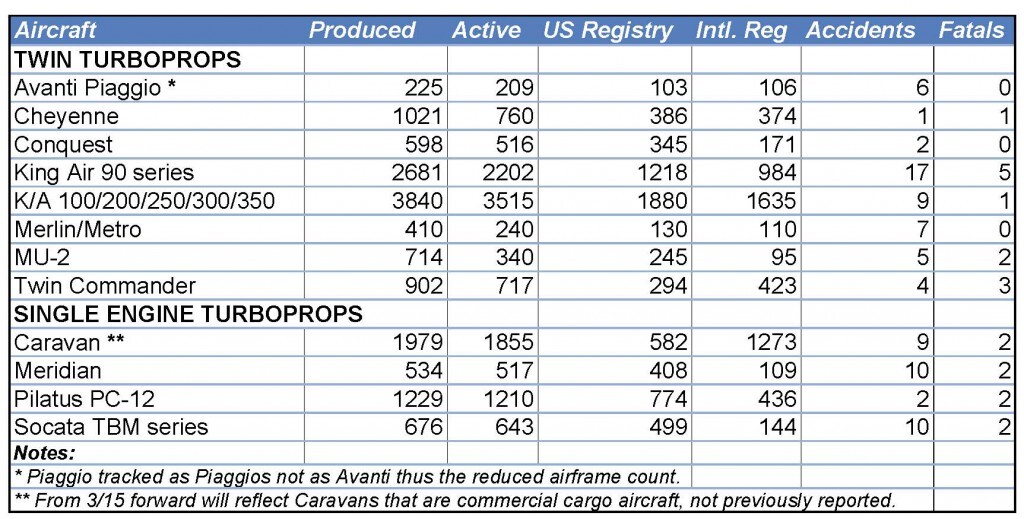By Dale Barnard
Greetings, Twin Commanders!
With 2013 a blip in the rear-view mirror, it is time to review the last quarter of 2013 for trends or anomalies as they apply to the turboprop fleets we’ve been tracking. Many factors influenced the turboprop fleets in the fourth quarter and 2013 overall. We saw OEM changes such as the revised Piaggio Avanti database and, of course, Cessna’s acquisition of the Beechcraft King Air family. A number of other factors left their mark as well. These include a tepid economy; technological advances in manufacturing materials; more intuitive avionic upgrades; the sunset of the accelerated depreciation tax provision; and a government that struggles to understand, let alone regulate, general aviation.
Once again we’re tracking eight mainstream twin turboprops, including Twin Commanders, and four mainstream single-engine turboprops, to compare and analyze their longevity and stability in the marketplace. Criteria include total production, active fleet, and registration. The analysis included accidents and incidents that occurred in the United States and were reported to the National Transportation Safety Board from 2010 through December 30, 2013.

These are raw numbers and do not attempt to show an aircraft’s likelihood to be involved in an accident. Some of the incidents reported are quite minor — slight damage after a wheel left a taxiway — and it’s worth noting that many similar incidents are not even reported.
Twin-turboprop 2013 trends we noted in earlier quarters continued through the fourth quarter for the most part. Here are the highlights:
TWIN TURBOPROPS
Piaggio Avanti database changes have resulted in 4th quarter reduction of its production numbers — 225 airframes, down 7 from the 232 airframes posted in the 3rd quarter.
Cheyennes and Commanders continue to lose active airframes. Twin Commander lost one aircraft and Cheyenne lost two this quarter alone. The migration from U.S.-based to international fleets continues as well for both manufacturers, with the international registries gaining five aircraft — two Cheyennes and three Commanders. Once again, these aircraft most often shift to Central and South American registries.
King Air 90 through 350s, the only twin turboprop tracked that remains in production, added 30 airframes. The active fleet increased by 35, meaning five aircraft re-entered service.
Conquests remain stable, with a worldwide fleet of 516. They continue to enjoy a stellar safety record.
The MU-2 population continues to shrink, losing three airframes in the 4th quarter.
Overall, demand for utility turboprops such as the King Air 90 through 350 workhorses remains strong. Although fleet depletion and parts availability are common discussion topics among MU-2 and Merlin operators, this is a key differentiator for Commanders. Twin Commanders enjoy strong service center support and adequate parts availability due to their active, committed OEM. While Cheyennes have a strong following like the Commanders, they lack the robust parts pipeline and service center support.
SINGLE-ENGINE TURBOPROPS
Unlike the twin-engine fleets, all four single-engine turboprops tracked remain in production. When looking overall at the single-engine turboprops, the high percentage of owner-flown populations in the Meridian and Socata TBM fleets clearly influence the resulting higher per-capita NTSB incidents in these two aircraft. In fact, in the four years from 2010 through 2013, these two aircraft experienced over 400 percent more incidents per active aircraft than the Caravan or Pilatus PC12, which have smaller owner-flown populations.
As in the 3rd quarter 2013, Caravan production, with 70 aircraft in the 4th quarter, continues to outpace the combined production of the remaining three single-engine turboprops. U.S. fleet numbers reflect 21 fewer airframes, while the international fleet increased by 88 airframes.
In another recurring trend, we continue to track the Pilatus PC12’s dramatic growth in its U.S. fleet numbers, while its international numbers remain stable.
The fleet dynamics of these two aircraft types create an interesting paradigm: Caravans show stronger international growth and demand than in its country of origin — the U.S. Conversely, Swiss-built PC12s post stronger growth and demand in the United States than abroad. Both fleets have a proportionately greater commercial demand than either the Meridian or TBM. Once again, the PC12 is the only platform showing consistent and significant U.S. fleet growth.
You may come to different conclusions about these numbers. Feel free to contact me at [email protected] or 360-635-80080 for vigorous debate, questions or comments.
Fly safe, Commanders!
Dale Bernard is Twin Commander Program Manager for NationAir Aviation Insurance (www.nationair.com)
